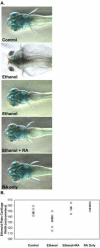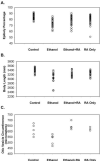Zebrafish fetal alcohol syndrome model: effects of ethanol are rescued by retinoic acid supplement
- PMID: 20036484
- PMCID: PMC2889201
- DOI: 10.1016/j.alcohol.2009.03.004
Zebrafish fetal alcohol syndrome model: effects of ethanol are rescued by retinoic acid supplement
Abstract
This study was designed to develop a zebrafish experimental model to examine defects in retinoic acid (RA) signaling caused by embryonic ethanol exposure. RA deficiency may be a causative factor leading to a spectrum of birth defects classified as fetal alcohol spectrum disorder (FASD). Experimental support for this hypothesis using Xenopus showed that effects of treatment with ethanol could be partially rescued by adding retinoids during ethanol treatment. Previous studies show that treating zebrafish embryos during gastrulation and somitogenesis stages with a pathophysiological concentration of ethanol (100mM) produces effects that are characteristic features of FASD. We found that treating zebrafish embryos with RA at a low concentration (10(-9)M) and 100mM ethanol during gastrulation and somitogenesis stages significantly rescued a spectrum of defects produced by treating embryos with 100mM ethanol alone. The rescued phenotype that we observed was quantitatively more similar to embryos treated with 10(-9)M RA alone (RA toxicity) than to untreated or 100mM ethanol-treated embryos. RA rescued defects caused by 100mM ethanol treatment during gastrulation and somitogenesis stages that include early gastrulation cell movements (anterior-posterior axis), craniofacial cartilage formation, and ear development. Morphological evidence also suggests that other characteristic features of FASD (e.g., neural axis patterning) are rescued by RA supplement.
Published by Elsevier Inc.
Figures




Similar articles
-
Zebrafish retinal defects induced by ethanol exposure are rescued by retinoic acid and folic acid supplement.Alcohol. 2015 Mar;49(2):149-63. doi: 10.1016/j.alcohol.2014.11.001. Epub 2014 Nov 26. Alcohol. 2015. PMID: 25541501 Free PMC article.
-
Retinoic acid prevents synaptic deficiencies induced by alcohol exposure during gastrulation in zebrafish embryos.Neurotoxicology. 2017 Sep;62:100-110. doi: 10.1016/j.neuro.2017.05.011. Epub 2017 Jun 3. Neurotoxicology. 2017. PMID: 28587808
-
Ethanol induces embryonic malformations by competing for retinaldehyde dehydrogenase activity during vertebrate gastrulation.Dis Model Mech. 2009 May-Jun;2(5-6):295-305. doi: 10.1242/dmm.001420. Epub 2009 Apr 6. Dis Model Mech. 2009. PMID: 19380308 Free PMC article.
-
Fetal Alcohol Spectrum Disorder: Embryogenesis Under Reduced Retinoic Acid Signaling Conditions.Subcell Biochem. 2020;95:197-225. doi: 10.1007/978-3-030-42282-0_8. Subcell Biochem. 2020. PMID: 32297301 Review.
-
The chick embryo as a model for the effects of prenatal exposure to alcohol on craniofacial development.Dev Biol. 2016 Jul 15;415(2):314-325. doi: 10.1016/j.ydbio.2016.01.007. Epub 2016 Jan 14. Dev Biol. 2016. PMID: 26777098 Review.
Cited by
-
Alcohol induced NLRP3 inflammasome activation in the brain of rats is attenuated by ATRA supplementation.Brain Behav Immun Health. 2019 Dec 16;2:100024. doi: 10.1016/j.bbih.2019.100024. eCollection 2020 Feb. Brain Behav Immun Health. 2019. PMID: 38377424 Free PMC article.
-
Retinal Wnt signaling defect in a zebrafish fetal alcohol spectrum disorder model.PLoS One. 2018 Aug 1;13(8):e0201659. doi: 10.1371/journal.pone.0201659. eCollection 2018. PLoS One. 2018. PMID: 30067812 Free PMC article.
-
Zebrafish models of fetal alcohol spectrum disorders.Genesis. 2021 Nov;59(11):e23460. doi: 10.1002/dvg.23460. Epub 2021 Nov 5. Genesis. 2021. PMID: 34739740 Free PMC article. Review.
-
A comparison of the different animal models of fetal alcohol spectrum disorders and their use in studying complex behaviors.Front Pediatr. 2014 Sep 3;2:93. doi: 10.3389/fped.2014.00093. eCollection 2014. Front Pediatr. 2014. PMID: 25232537 Free PMC article. Review.
-
Elf3 deficiency during zebrafish development alters extracellular matrix organization and disrupts tissue morphogenesis.PLoS One. 2022 Nov 16;17(11):e0276255. doi: 10.1371/journal.pone.0276255. eCollection 2022. PLoS One. 2022. PMID: 36383615 Free PMC article.
References
-
- Abramoff MD, Magelhaes PJ, Ram SJ. Image Processing with ImageJ. Biophotonics International. 2004;11:36–42.
-
- Begemann G, Meyer A. Hindbrain patterning revisited: timing and effects of retinoic acid signalling. Bioessays. 2001;23:981–986. - PubMed
-
- Begemann G, Schilling TF, Rauch GJ, Geisler R, Ingham PW. The zebrafish neckless mutation reveals a requirement for raldh2 in mesodermal signals that pattern the hindbrain. Development. 2001;128:3081–3094. - PubMed
-
- Blader P, Strahle U. Ethanol impairs migration of the prechordal plate in the zebrafish embryo. Dev. Biol. 1998;201:185–201. - PubMed
-
- Bradfield JY, West JR, Maier SE. Uptake and elimination of ethanol by young zebrafish embryos. Neurotoxicol. Teratol. 2006;28:629–633. - PubMed
Publication types
MeSH terms
Substances
Grants and funding
LinkOut - more resources
Full Text Sources
Medical

